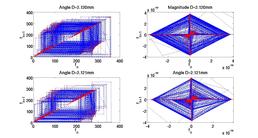On the applicability of nonlinear timeseries methods for partial discharge analysis
- Started
- 1st November 2012
- Ended
- 1st January 2014
- Research Team
- Lyuboslav Petrov
- Investigators
- Paul Lewin
Partial Discharges are localized dielectric breakdowns in power systems. They can be a product of manufacturing defects, mechanical and electromechanical stressing, chemical degradation, a combination of them and others. PDs are a dynamical self-enhancing process, whereby once incepted they accelerate the degradation of the dielectric and the intensity of their impact. They are therefore regarded as a prerequisite to high and medium voltage systems failure. The motivation of developing new and improving upon existing PD analysis methodologies is growing as the existing power demand is growing and assets are ageing, where many operate beyond their engineered lifespan. In addition, the drive towards decentralized generation technologies, demand-side control and the increased use of power electronics interrupt the power flow in the grid, increase harmonic content and power fluctuations thereby further increasing the risk of failure of power systems. PD detection, classification and localization schemes have been developed throughout the course of the past century and a multitude of commercially available apparatuses and techniques exist. PD measurements are generally non-intrusive and can be performed through different media (e.g. sensing of acoustic and light emissions, and electrical signals). The data analysed in this work is solely from electrical signals, where pulses induced on surrounding conductors due to charge transfer at the instance of discharge are measured at some distance away from the site. The distance varies in several magnitudes and is in most real-world scenarios unknown a-priory, by definition. Induced pulses even from different physical mechanisms can be assumed as a Dirac delta function with a decay period of only several nanoseconds. As the pulse propagates through the circuit towards the sensor, it will be attenuated and dispersed according to the line’s propagation characteristics and geometry. The pulse waveform received at the sensor is therefore a strong candidate for localisation of the defect as well as for multiple source identification (e.g. different pulse waveforms are produced by different paths travelled, hence are discernible as separate sources), however classification of the physical mechanism producing the pulse cannot be made using solely the measured pulse shape. For discriminating between various defects the statistical and dynamical characteristics of the phenomena are used. These analyses represent a PD event as a point process in two dimensions, namely the phase of occurrence and its maximum magnitude. Application of statistical and nonlinear methods to the produced sequences enables reliable PD event classification. This work examines the applicability of two nonlinear methods, namely the Generalized Hurst Exponent (GHE) and Lempel Ziv Complexity (LZ). A novel testing procedure using surrogate data is developed to test the statistical significance of the invariants, with the following objectives: • Does the process contain a deterministic footprint? • Can the level of the system on the continuum between stochasticity and determinism be employed for classification?
Categories
Physical Systems and Engineering simulation: Acoustics, Electromagnetism, Energy, Heat transfer, Semiconductors, Sensors
Algorithms and computational methods: FFT, Finite differences, Finite elements, Machine learning, Molecular Dynamics, statistical analysis
Software Engineering Tools: Git, Mercurial
Programming languages and libraries: C, Matlab
Computational platforms: Linux
Transdisciplinary tags: Complex Systems, Scientific Computing, Visualisation
